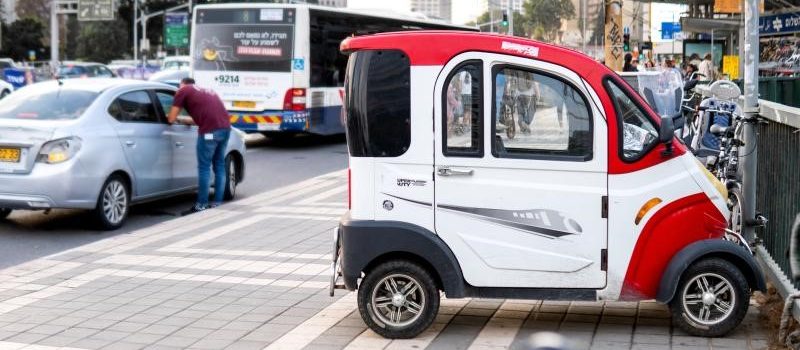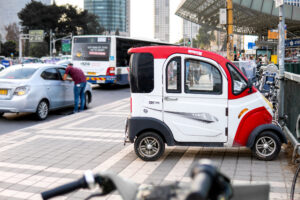5 Trends That Could Transform How People Get Around Their Communities

By Jason Islas
This post originally appeared on The Fuse by the Coalition for Reimagined Mobility.
Improving battery technology, innovative vehicle design, increased infrastructure connectivity, and changing attitudes toward transportation have all laid the groundwork for a potential revolution in how people get around the places they live and work.
These five trends could transform how people get to jobs, shop, meet up with friends, and get their kids to school. But only if policymakers choose to support these trends and allow for greater innovation that increases the mobility choices people have when planning their trips.
Over the following weeks, Dr. Kim Watts, ReMo’s Policy Manager for Passenger Transportation, will explore more in depth how these five transportation trends—given a favorable policy environment—can create a future where getting from point A to point B is more convenient, accessible, energy efficient, and sustainable.
These trends have the potential to save people time and money while reducing harmful greenhouse gas emissions and the transportation sector’s reliance on oil to keep the global economy running.
A Shift in Perspective: People Increasingly Understand Mobility as Part of Larger Social, Economic, and Environmental Systems
Now more than ever, planners and policymakers understand the impacts mobility has on the environment and access to economic opportunity. Transportation affects how—or even if—people can readily access jobs, schools, grocery stores, and other essential goods and services.
This has many municipal governments asking what transportation innovations are “worth it” in terms of providing people convenient, affordable, and sustainable mobility. The e-scooter boom opened this question, but new modes will continue to emerge and understanding their potential and how best to use them to achieve larger systemic goals will be key.
We’ll dive further into this in part by looking at how startup ClimateView’s new platform ClimateOS is helping cities plan more holistically.
A Menu of Transportation Options—Served Up with Your Insurance Policy?
People increasingly want more choices for getting around than either driving their own car or taking a bus or train. As new modes emerge, though, how can people access different options as effortlessly as possible?
What if a menu of mobility options—a mobility pass that includes transit, subscription to a shared, electric car service, access to shared e-scooters or small three-wheeled vehicles—came as a feature included in your housing costs, insurance policy, or when you open a bank account?
Offering mobility as a service (MaaS) bundled with other essential services could fundamentally alter how people access transportation.
Mobility Hubs: A One-Stop Shop for Transportation Choice
Cities have already begun experimenting with mobility hubs, where people can find a selection of transportation options, including traditional transit, bicycle, and scooter sharing, carsharing, and EV charging.
 These hubs have already shown promise in getting people out of privately-owned cars and onto other modes of mobility because they offer convenient, safe, reliable, and flexible alternatives. European funded-research has recently identified some of the policy best practices to get the most out of mobility hubs.
These hubs have already shown promise in getting people out of privately-owned cars and onto other modes of mobility because they offer convenient, safe, reliable, and flexible alternatives. European funded-research has recently identified some of the policy best practices to get the most out of mobility hubs.
Ride-hailing giant Lyft is piloting a docked, station-based approach with its e-bikes and e-scooters in partnership with U.S. cities. And as Mercedes-Benz plans to invest $1 billion in fast-charging stations around retail and restaurants in the U.S., these areas could easily become commercially vibrant multimodal hubs.
A Renaissance of Vehicle Innovation
The popularity of two-wheeled micromobility options like e-bikes, mopeds, e-cargo bikes, and e-scooters shows the latent demand for flexible alternatives to private cars. E-bikes sales are, in fact, outpacing sales of electric cars in the U.S. and we can expect the popularity of these and similar vehicles to grow. These bikes are relatively inexpensive, require less upkeep, and allow people to avoid gridlock especially when making trips under five miles, which accounted for more than 60% of trips in the U.S. in 2021.
We should expect to see variations on smaller, light-weight electric vehicles—what some are calling innovation in minimobility—as entrepreneurs transform the traditional form of three and four-wheeled vehicles improving shared transportation options as well as people’s ability to own such vehicles.
Autonomous Vehicles Will Be Shared, Not Privately Owned
As autonomous vehicle (AV) tech continues to improve, it will be deployed first in shared, electric, autonomous shuttles. It is easier to deploy and test these technologies in specific, clearly defined areas, especially given public scrutiny of overly ambitious statements by tech CEOs and entrepreneurs.
Shared, electric autonomous vehicles have real potential to provide access where traditional transit has been lacking, and private vehicle ownership is too expensive and inefficient. A new brief from SAFE’s AV Initiative highlights how a shared, electric AV fleet in the U.S. could cut fuel consumption by half and reduce carbon emissions by 75%—while meeting the same level of demand as today’s transportation systems.
We’ll look closer at projects like “SHared automation Operating models for Worldwide adoption” (SHOW), which work with public and private sectors to catalyze shared AV projects around the globe.
More Transportation Choice or More of the Same?
While the above trends promise more access and choice, these are not inevitable. Policymakers would do well to notice how people are eager to have more mobility options in how they get around. Policies should leverage those desires and the private sector’s ability to innovate to catalyze a revolution in passenger transportation.
Jason Islas is the Senior Manager for Policy Communications at ReMo.
Stay tuned for more on these trends as we explore how we can get to a mobility future that offers a sustainable, efficient, and convenient transportation network that gives us choice and flexibility.
